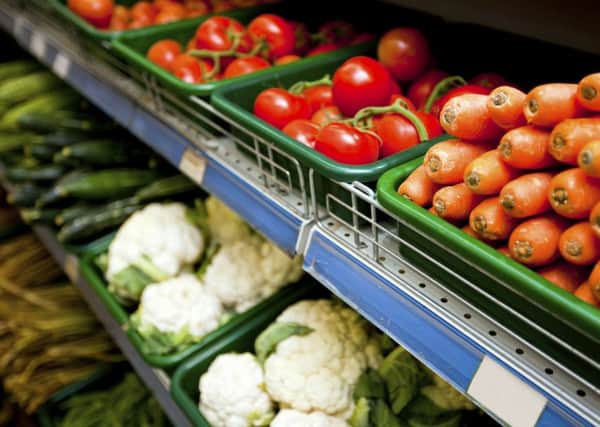Bill Jamieson: Housing market can breathe life into retail


Figures from the Scottish Retail Consortium last week showed Scottish retail sales were down 3.8 per cent compared with January 2015 – also down 2.3 per cent on the year before. This, says the SRC, was the weakest store performance since April 2012. Like-for-like sales (that is, stripping out the contribution from new store space) fell by 4 per cent on last January, which was itself down by 3.1 per cent.
Adding in online sales, the picture is not so bleak. Total non-food sales rose by 0.2 per cent on January last year, in sharp contrast to a 1.1 per cent decline then recorded on a year earlier.
Advertisement
Hide AdAdvertisement
Hide AdDavid Lonsdale, director of the Scottish Retail Consortium, could find little to cheer in the figures: “There is no denying that these are dour retail sales figures for January, showing a decline of 2 per cent even once falling shop price inflation is taken into account. After the excess of the festive period, which saw solid retail sales growth in December, shoppers were clearly keeping a firm grip on purse strings and wallets in January even as footfall improved.”
Supermarkets look to have had the worst of it, with a 5.8 per cent fall in total food sales in January compared with a year ago. Rotten weather may have played a big part in keeping us indoors. But did we really spend 5.8 per cent less on food and instead fall back on leftovers at the back of the fridge? There’s surely only so many abandoned Brussels sprouts that even David Lonsdale can eat.
These are depressing figures for anyone in the retail trade and indeed for the economy overall, suggesting cash-strapped and shop-weary consumers struggling to catch up with December’s credit card bills.
But arguably the most eyebrow- raising feature of them all is the sharp contrast with the UK overall. Here figures out last week showed retail sales volumes surged 2.3 per cent month-on-month in January and a 5.2 per cent jump on a year-on-year comparison.
Taking the latest quarterly figures to gain an impression of underlying trend, retail sales volumes were up 1.4 per cent in the three months to January compared to the three months to October.
All retail sectors saw strong growth in January, led by sales of textiles and clothing up 3.3 per cent month-on-month. Online sales were up 2.7 per cent – and by 10.4 per cent year-on-year in January.
What might explain the discrepancy between the Scottish and UK figures? We might blame the lousy weather – January saw 145 per cent of average rainfall and only 63 per cent of average sunshine in Scotland – but large parts of England were also hit by heavy rainfall.
Then there may be labour market factors. Scotland’s unemployment rate is slightly higher than that for the UK overall (5.8 per cent against the UK’s 5.1 per cent) but numbers employed in Scotland rose by 22,000 over the three months October to December 2015 and the employment number at 2.64 million stands at a new record high.
Advertisement
Hide AdAdvertisement
Hide AdFor some, all this is a side issue compared with the bigger picture of an economy still heavily reliant on the consumer sector. Much has been made of the need for a rebalancing and a stronger manufacturing sector – but Chancellor George Osborne’s “March of the Makers” is looking more like the lost Ninth Roman Legion.
And further upward surprises on consumer spending cannot be counted on. A notable feature of the latest labour market report is that earnings growth continues to slow. This was running at 3 per cent in the three months to August, and has now slowed to 1.9 per cent in the October-December quarter. It hardly suggests a sustained spending surge on the horizon.
It is all too easy to get depressed over the “unbalanced economy” thesis and the difficulties in effecting a greater contribution from sectors such as manufacturing and construction. But I am not sure that the reliance on the household/service sector for growth is as much of a negative as some make out. Consumer spending provides a diffuse lift to demand for goods and services across the economy – clothing, durable goods, electronics, health and lifestyle products and leisure spending.
And we should not overlook the contribution made by enhanced household commitment to the biggest consumer purchase of all: housing. Last week the Council of Mortgage Lenders reported gross mortgage lending up by a cracking 21 per cent year-on-year in January. Housing market activity has started the year on a strong note – as Global Insight economist Howard Archer points out, it is the strongest January performance since 2008.
While this is probably being influenced by buy-to-let investors looking to make a purchase before April’s rise in Stamp Duty for the sector, the signals over lower-for-longer interest rates may also be boosting household confidence and housing market activity. Markit’s Household Finance Index shows the number of respondents expecting an interest rate hike within a year fell back to 46 per cent in February from 71 per cent in January.
And this in turn triggers wider consumer spending on home improvement and renovation and the myriad of household items that follow on from property purchases.
The need for a healthy retail sector cannot be overestimated. And why should this particularly matter to Holyrood? As Lonsdale points out, “with half of VAT receipts being assigned to the Scottish Parliament our politicians at Holyrood have a direct stake in facilitating a flourishing retail industry”. Out of the paradox, a clear message for us all. «